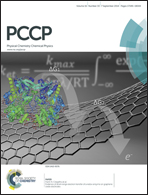Noble gas encapsulation: clathrate hydrates and their HF doped analogues†
Abstract
The significance of clathrate hydrates lies in their ability to encapsulate a vast range of inert gases. Although the natural abundance of a few noble gases (Kr and Xe) is poor their hydrates are generally abundant. It has already been reported that HF doping enhances the stability of hydrogen hydrates and methane hydrates, which prompted us to perform a model study on helium, neon and argon hydrates with their HF doped analogues. For this purpose 512, 51268 and their HF doped analogues are taken as the model clathrate hydrates, which are among the building blocks of sI, sII and sH types of clathrate hydrate crystals. We use the dispersion corrected and gradient corrected hybrid density functional theory for the calculation of thermodynamic parameters as well as conceptual density functional theory based reactivity descriptors. The method of the ab initio molecular dynamics (AIMD) simulation is used through atom centered density matrix propagation (ADMP) techniques to envisage the structural behaviour of different noble gas hydrates on a 500 fs timescale. Electron density analysis is carried out to understand the nature of Ng–OH2, Ng–FH and Ng–Ng interactions. The current results noticeably demonstrate that the noble gas (He, Ne, and Ar) encapsulation ability of 512, 51268 and their HF doped analogues is thermodynamically favourable.


 Please wait while we load your content...
Please wait while we load your content...